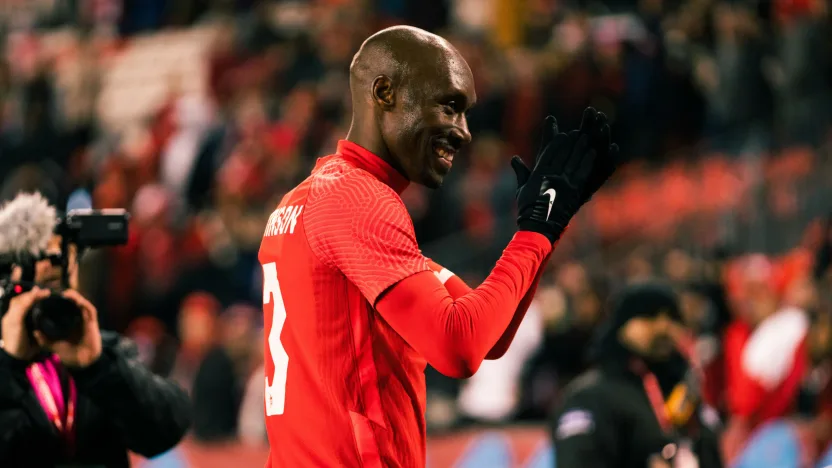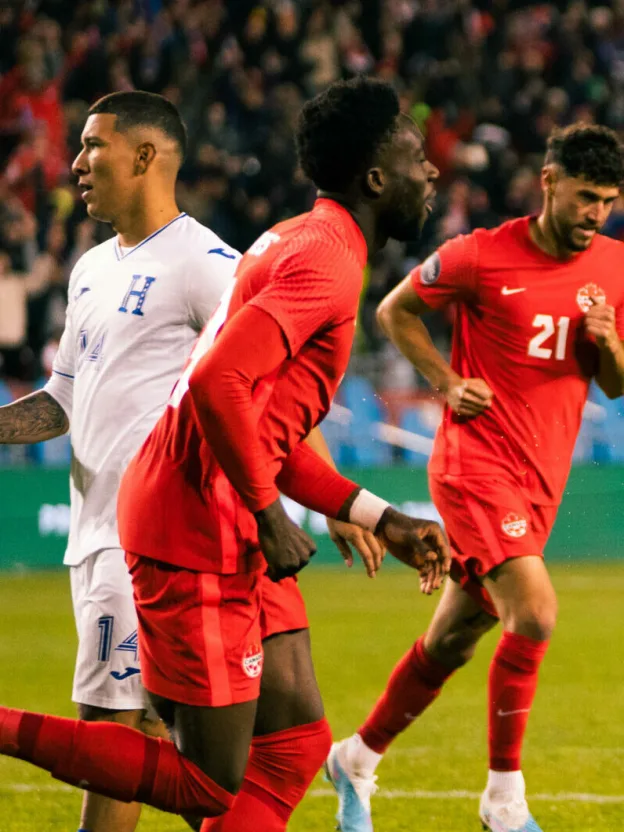Final Score: Canada 4-1 Honduras
Goalscorers: Larin 9′, 11′, David 50′, Osorio 86′; Benguché 73′
2022-23 Concacaf Nations League A — Group C
Match in a minute or less
The Canadian men’s national team clinched first place in Group C of the Concacaf Nations League on Tuesday, beating Honduras 4-1 at Toronto’s BMO Field to book a spot in the semifinals in Las Vegas. Playing in Toronto for the first time since qualifying for the 2022 World Cup, Canada came out of the gates firing, and on the cusp of the ninth minute they found the net as a glorious interchange from the left flank between Alphonso Davies, Jonathan Osorio, and Cyle Larin gave Larin a chant to slot home coolly from about 10 yards out. Then, just two minutes later, Larin struck again — this time smashing home a header off a perfectly-placed in-swinging corner by Stephen Eustáquio at the back post. Larin had a golden opportunity to complete the hat-trick in the first half when Canada won a penalty in the 41st minute — a handball off an Ismaël Koné shot — but the Real Valladolid striker put his attempt well wide of the right post. Just after halftime, it was Jonathan David who extended the lead as he pounced on a ball Larin couldn’t quite wrap his foot around to make it 3-0 in the 50th minute. Honduras clawed one back in the 73rd minute as Jorge Benguché flicked in a well-delivered corner kick, but the Canadians nonetheless saw out the victory comfortably, as Jonathan Osorio added a fourth in the 86th minute thanks to a gorgeous Ayo Akinola flick-on.
Three Observations
Confident CanMNT book Nations League semifinal, more pressure tests
The men’s national team’s unbeaten streak at BMO Field is now at 23 games, and they’ve beaten Honduras in Toronto for the first time ever. Part of the goal for Canada heading into this international window was to continue establishing themselves as a permanent powerhouse in Concacaf, and not just a team of destiny from World Cup Qualifying. Canada secured first place in Group C of Nations League A, and in doing so they guaranteed themselves a semifinal date with Panama in Las Vegas in June. By the way Canada carried themselves on Tuesday, they’ll be in with a chance of winning the whole Nations League — they’ll certainly feel so, at least. “Prior to the game we talked about, if you want to be part of Concacaf’s elite, you have to be in these final moments,” head coach John Herdman said postmatch. “You’ve got to get into these big events. It’s the first time in our history to get to a Nations League final, and I think this group believe they can win it.” With just under 65 per cent possession and more than 600 completed passes (with 93 per cent accuracy), Canada dominated from start to finish, with only the smallest handful of hiccups. More on just how they neutralized Honduras later, but in general Canada played comfortably from kickoff playing in a stadium where they feel immense confidence. The benefits of this individual win will help colour the next several years of the national team program. With no qualifying campaign ahead of the 2026 World Cup, Canada are in dire need of competitive, challenging tests against strong opposition — as many of them as possible in the next few years.
By winning on Tuesday, Canada made significant progress toward qualifying for the 2024 Copa América — they’ll get a bye to the quarter-finals of the next Nations League, and they’ll need to win either that or a subsequent play-in round to qualify — where they could play some of the world’s best teams. “If this team’s not getting tier one matches consistently, we are wasting our time,” Herdman added. “They have to get those experiences, because when you come up against a midfield three of [Marcelo] Brozović, [Mateo] Kovaćić and [Luka] Modrić, it’s another level. They can find gears, and you have to have those experiences.” In the more immediate future, Canada get at least one high-stakes knockout match in June at the Nations League final four, where they’ll be hungry to play in a final against the United States or Mexico, and vie to win the men’s team’s first trophy since 2000. “It’s something that’s missing for us,” Atiba Hutchinson said postmatch of the chance to win a trophy. “We need to start showing we’re a dominant force here in Concacaf.” Qualifying for that final four in Vegas was a minimum expectation for Canada, but it sets the program up nicely for the long road to the next World Cup.
Three-man midfield the clear way forward as Koné shines again
Twenty-year-old Watford midfielder Ismaël Koné won just his 11th cap for the senior national team — and third start — but already he looks like an ironclad fixture in the middle for this Canada’s future. Playing alongside Porto star Stephen Eustáquio and key veteran Jonathan Osorio, Koné didn’t look out of place for a second, moving the ball with incredible confidence. Koné was repeatedly the midfielder tasked with playing long switches out to either wing, given his ability to play the ball accurately with either foot. Defensively, he was able to handle the physical threat of the Hondurans well and used his frame to protect or recover the ball several times. John Herdman has tinkered with his team’s shape repeatedly over the past year and a half, but it’s becoming clear — particularly since the Croatia match at the World Cup — that they’re often better with three central midfielders rather than two. Adding Osorio to the mix in front of Eustáquio and Koné (or Hutchinson, as was the pairing against Croatia) not only gives Canada another passing focal point, but helps limit space centrally for opposing sides to play through. As a result, Canada dominated the middle of the park against Honduras. Of course, this opposition is not nearly the same as what Canada saw in Qatar, but the theory remains strong that it’s better for Canada to control midfield with a numerical advantage. Postmatch, Herdman called Koné’s shift against Honduras “one of the best midfield performances I’ve ever seen in my time of being here.” Atiba Hutchinson was honoured before the match for banking his 100th cap, and he’s long been the focal point of Canada’s midfield. He came off the bench on Tuesday — to play next to Koné in the middle, of course — but the 40-year-old’s career is in its twilight. Thankfully for Canada, it was clearer than ever on Tuesday that the midfield will be in excellent hands after his retirement. “[The ceiling is] very, very high for him,” Hutchinson said of Koné after the game. “He’s a young player with so much potential and a lot of maturity. You can see that not a lot fazes him, he’s playing like he’s playing in his backyard.”

Tight marking neutralizes Honduran transition threat
Every time Canada have played Honduras under John Herdman, the head coach has stressed how dangerous he believes the Hondurans can be in transition — usually, singling out CF Montréal forward Romell Quioto in particular. Alistair Johnston, a former teammate of Quioto’s in Montréal, said likewise on Monday, identifying how the speedy winger might hurt Canada on the counter. On Tuesday, the Canadians were well prepared for that exact threat that has been a problem before. Johnston, in particular, seemed tasked explicitly with marking Quioto tightly. The Celtic fullback — playing at right centre-back as he often does for Canada — constantly kept tabs on Quioto, scanning the pitch for him specifically every five seconds at most. Indeed, Johnston seemed to be the only one of Canada’s back three with license to step out of the well-organized line to take away space from Quioto if necessary. Honduras were noticeably missing Alberth Elis, typically part of a strong one-two attacking punch with Quioto; coach Diego Vásquez confirmed postmatch that he was unavailable on Tuesday despite playing in the team’s friendly against El Salvador earlier this window. The handful of occasions where Johnston stepped forward in possession but Canada lost the ball, Johnston’s workrate to return to Quioto’s side was tremendous. It was a frustrated Quioto who exited the match in the 68th minute, having barely touched the ball — he had zero expected goals, lost all three of his duels, and couldn’t find an inch of space.
In general, Honduras stepped perhaps a little higher than expected when Canada played out of the back — particularly after the early goal — which allowed the hosts to pass through them more easily than usual. Canada — Koné and Osorio especially — played a lot of quick one-two passes to break lines and progress the ball, with Honduras less compact than they typically are. The game plan from Herdman was solid and well-designed to neutralize specific threats, and the personnel executed it perfectly. The only time they were beaten was a set-piece in the 73rd minute, when the cross came in over Johnston’s head for a flicked finish by Jorge Benguché. Winning balls in the air remains perhaps the only major area for Johnston to improve, but aside from that one moment the defensive performance was near-flawless.
CanPL.ca Pla****yer of the Match
Cyle Larin, Canada
The men’s national team’s all-time leading scorer added to his lead with a pair of goals within a couple minutes of each other in the first half, scoring two excellent striker’s finishes. He was a force throughout his 62-minute shift, showing up constantly in dangerous pockets and pressing the backline.
What’s next?
Canada’s next steps in the Concacaf Nations League will be the semifinal against Panama in Las Vegas, currently set for June 15, where they’ll vie for a meeting in the final with either the United States or Mexico.
